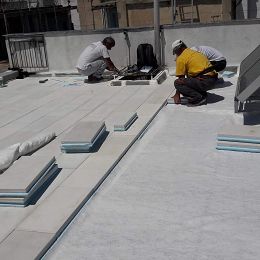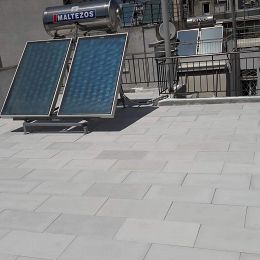
In the case of inverted roof top insulation the waterproofing is placed beneath the thermal insulation layer. In “open type” insulations, thermal insulation materials are exposed to water on rainy days and this results in the temporary decrease in the thermal insulation capability.
Inverted insulation is usually recommended for rooftops where discharge flows or even waterproofing is already installed and an affordable thermal insulation method is sought after.
Application method:
Surface is diligently cleaned and evened out by scraping off protruding or loose mortar and small depressions are repaired.
Primer is applied to the entire length and width of the area that is to be waterproofed using asphalt varnish Primer (solvent-based). This varnish enhances the adhesion of the bituminous sheet to the underlay and prevents it from peeling away at the edges.
This is followed by the thermal adhesion of the Dien Energy ++ bituminous sheet, superior quality, (SBS), weight6 kgs, with an upper layer ofwhite mineral tile, and elasticity at -20 °C and 180 gr spun bond polyester reinforcement. The thermal adhesion of the bituminous sheet to the underlay is done using the appropriate open-flame torch. The bituminous sheets are adhered in parallel to one another in order to ensure that water flows freely. The overlapping of the bituminous sheets in 10 centimetres lengthwise and at least 15 centimetres at the ends. During adhesion, the overlapping bituminous sheets are pressed lightly until the fusion of the material emerges at the joint; this is evidence that the adhesion of the bituminous sheets has been sealed. We extend 18 to 20 centimetres up the parapet and on occasion we cover the entire parapet. Specially-shaped bituminous sheet pieces are placed on solar panels, tanks, pipe sleeves, downspouts, pipes, as well as all the vulnerable points.
The insulation is strengthened with the application of an elastoplastic acrylic and polyurethane sealant, along all the edges, at the point where the edge of the bituminous sheet meets the parapet or wall. This method essentially eliminates any chance of the bituminous sheet detaching all the edge despite the strain it is under. These are materials with high elasticity and maximum resistance to UV radiation (-20°C ~ 90°C ).
Installation of extruded polystyrene thermal insulation tiles Dow, at least 5 centimetres thick.
Installation of 200 gr geotextile to protect the thermal insulation material and to separate it from the final coating.
Placement of gravel or pebble or free slabs or composite thermal insulating tile (Polytile by Dow).
Optionally:
Based on national standards, a second layer of bituminous sheet which is installed parallel to the first layer with a 50 cm shift is optionally recommended for further reinforcement of all roof top insulations.
It is possible for the drainage membrane (extruded polyethylene sheets with a cross-sectional dimension of 6 mm - HDPE) to be applied to the thermal insulation layer, so that the thermal insulation materials come into contact with as little as rainwater possible.

 Rooftop thermal insulation
Rooftop thermal insulation

 Rooftop thermal insulation
Rooftop thermal insulation
The benefits of inverted rooftop insulation:
Inverted rooftop insulation offers satisfactory thermal insulation.
The existing rooftop waterproofing is protected from ageing and thermal strain.
The thermal insulation layer can be reused in case of a building addition or extension.
It is affordable and the construction cost is amortised within five years.
Customer reviews for our Thermal Insulations

